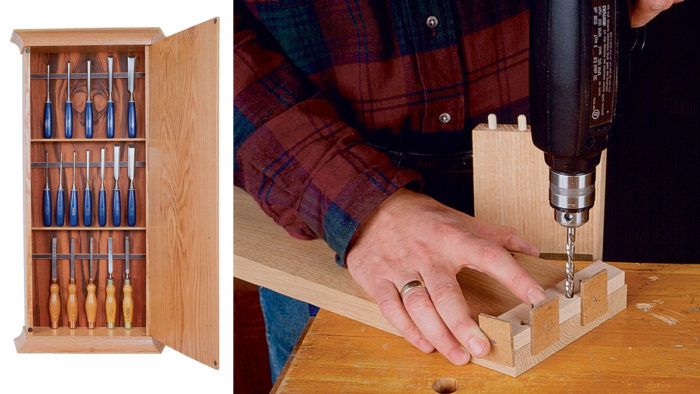
Synopsis: Inspired by the work of James Krenov, Carl Dorsch designed a small, single-door wall cabinet for his chisel collection, and though it’s on the extravagant side, he says the piece is fun and easy to make. It uses a warped panel left from another project; he made the door first and built the cabinet to fit. He made cove molding from two 4-ft.-long pieces of stock, and explains what he did to hang that unique door. Dorsch made his own magnetic chisel holders and explains how to follow suit. A detailed project plan illustrates his design.
Wood chisels are some of my favorite tools. I have a rather extensive collection that includes two sets of beveledge chisels: one set of five for general work and one set of seven for fine paring. Rounding out this collection are a couple of firmer chisels and three mortise chisels that I made. I had built a large, double-door cabinet for my handplane collection, and there was enough space on the doors to hang the chisels. But I knew I would despise the rattling when opening and closing the cabinet doors; besides, I wanted to store the chisels in their own case to reflect my appreciation for them.
The small, single-door wall cabinet shown here is perfect for the chisels. Although a bit extravagant, the cabinet fulfills my storage needs and was fun and easy to make. Cabinet construction is straightforward. The two sides are doweled into the bottom and top, as shown in figure 1 on the facing page, and angle toward the front at 15°; the cross-grain quartersawn oak sides further emphasize the concave door. The chisel handles rest on narrow shelves and magnetic strips hold them in place. You could substitute deeper shelves and other fasteners to display your favorite collectibles. Tablesawn cove moldings trim the top and bottom.
Building the cabinet
My chisel cabinet was inspired by James Krenov. After seeing a curved-panel cabinet he had made, I knew just what to do with a warped panel left over from another project. I had glued up the book-matched, in.-thick oak panel, but never used it because it bowed about in. across its width. While nature did a good job creating the curved panel that became the door on my chisel cabinet, a more controlled approach would be to cooper the door by gluing up beveled staves and then shaping the panel with a round-bottom plane. This way, the door can be made to predetermined specifications to suit your requirements. For this project, though, I would still make the door first and then build the cabinet carcase to fit.
From Fine Woodworking #89
For the full article, download the PDF below:
Fine Woodworking Recommended Products

Starrett 4" Double Square

Drafting Tools

Suizan Japanese Pull Saw




















Log in or create an account to post a comment.
Sign up Log in